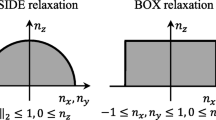Abstract
Shape from Shading (SfS) is one of the oldest problems in image analysis that is modelled by partial differential equations (PDEs). The goal of SfS is to compute from a single 2-D image a reconstruction of the depicted 3-D scene. To this end, the brightness variation in the image and the knowledge of illumination conditions are used. While the quality of models has reached maturity, there is still the need for efficient numerical methods that enable to compute sophisticated SfS processes for large images in reasonable time. In this paper we address this problem. We consider a so-called Fast Marching (FM) scheme,which is one of the most efficient numerical approaches available. However, the FM scheme is not trivial to use for modern non-linear SfS models. We show how this is done for a recent SfS model incorporating the non-Lambertian reflectance model of Phong. Numerical experiments demonstrate that – without compromising quality – our FM scheme is two orders of magnitude faster than standard methods.
Preview
Unable to display preview. Download preview PDF.
Similar content being viewed by others
References
Horn, B.K.P., Brooks, M.J.: Shape from Shading. Artificial Intelligence Series. MIT Press, Cambridge (1989)
Zhang, R., Tsai, P.S., Cryer, J.E., Shah, M.: Shape from shading: A survey. IEEE Transactions on Pattern Analysis and Machine Intelligence 21(8), 690–706 (1999)
Tankus, A., Sochen, N., Yeshurun, Y.: A new perspective [on] shape-from-shading. In: Proc. Ninth International Conference on Computer Vision, vol. 2, pp. 862–869. IEEE Computer Society Press, Nice (2003)
Tankus, A., Sochen, N., Yeshurun, Y.: Perspective shape-from-shading by fast marching. In: Proc. 2004 IEEE Computer Society Conference on Computer Vision and Pattern Recognition, vol. 1, pp. 43–49. IEEE Computer Society Press, Washington (2004)
Prados, E., Faugeras, O.: Shape from shading: A well-posed problem? In: Proc. 2005 IEEE Computer Society Conference on Computer Vision and Pattern Recognition, vol. 2, pp. 870–877. IEEE Computer Society Press, San Diego (2005)
Ahmed, A., Farag, A.: A new formulation for shape from shading for non-Lambertian surfaces. In: Proc. 2006 IEEE Computer Society Conference on Computer Vision and Pattern Recognition, vol. 2, pp. 17–22. IEEE Computer Society Press, New York (2006)
Oren, M., Nayar, S.: Generalization of the Lambertian model and implications for machine vision. Vogel-International Journal of Computer Vision 14(3), 227–251 (1995)
Vogel, O., Breuß, M., Weickert, J.: Perspective shape from shading with non-Lambertian reflectance. In: Rigoll, G. (ed.) DAGM 2008. LNCS, vol. 5096, pp. 517–526. Springer, Heidelberg (2008)
Phong, B.T.: Illumination for computer-generated pictures. Communications of the ACM 18(6), 311–317 (1975)
Tsitsiklis, J.N.: Efficient algorithms for globally optimal trajectories. IEEE Transactions on Automatic Control 40(9), 1528–1538 (1995)
Sethian, J.A.: Level Set Methods and Fast Marching Methods, 2nd edn. Cambridge University Press, Cambridge (1999)
Kimmel, R., Sethian, J.A.: Optimal algorithm for shape from shading and path planning. Vogel-Journal of Mathematical Imaging and Vision 14(3), 237–244 (2001)
Yuen, S.Y., Tsui, Y.Y., Chow, C.K.: Fast marching method for shape from shading under perspective projection. In: Proceedings of the 2nd IASTED International Conference on Visualization, Imaging and Image Processing, Malaga, Spain, September 2002, pp. 584–589 (2002)
Tankus, A., Sochen, N., Yeshurun, Y.: Shape-from-shading under perspective projection. International Journal of Computer Vision 63(1), 21–43 (2005)
Prados, E., Soatto, S.: Fast marching method for generic shape from shading. In: Paragios, N., Faugeras, O., Chan, T., Schnörr, C. (eds.) VLSM 2005. LNCS, vol. 3752, pp. 320–331. Springer, Heidelberg (2005)
Yuen, S.Y., Tsui, Y.Y., Chow, C.K.: A fast marching formulation of perspective shape from shading under frontal illumination. Pattern Recognition Letters 28, 806–824 (2007)
Cristiani, E., Falcone, M., Seghini, A.: Some remarks on perspective shape-from-shading models. In: Sgallari, F., Murli, F., Paragios, N. (eds.) SSVM 2007. LNCS, vol. 4485, pp. 276–287. Springer, Heidelberg (2007)
Vogel, O., Breuß, M., Weickert, J.: A direct numerical approach to perspective shape-from-shading. In: Lensch, H., Rosenhahn, B., Seidel, H.P., Slusallek, P., Weickert, J. (eds.) Vision, Modeling, and Visualization, pp. 91–100. AKA, Berlin (2007)
Author information
Authors and Affiliations
Editor information
Editors and Affiliations
Rights and permissions
Copyright information
© 2009 Springer-Verlag Berlin Heidelberg
About this paper
Cite this paper
Vogel, O., Breuß, M., Leichtweis, T., Weickert, J. (2009). Fast Shape from Shading for Phong-Type Surfaces. In: Tai, XC., Mørken, K., Lysaker, M., Lie, KA. (eds) Scale Space and Variational Methods in Computer Vision. SSVM 2009. Lecture Notes in Computer Science, vol 5567. Springer, Berlin, Heidelberg. https://doi.org/10.1007/978-3-642-02256-2_61
Download citation
DOI: https://doi.org/10.1007/978-3-642-02256-2_61
Publisher Name: Springer, Berlin, Heidelberg
Print ISBN: 978-3-642-02255-5
Online ISBN: 978-3-642-02256-2
eBook Packages: Computer ScienceComputer Science (R0)




